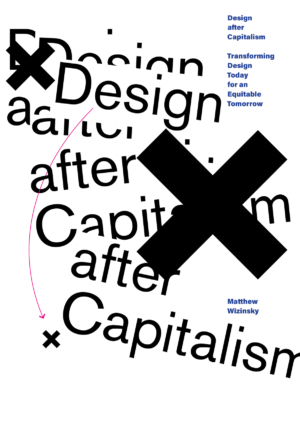Spring 2023
Another world is possible
Design After Capitalism: Transforming Design Today for an Equitable Tomorrow
By Matthew Wizinsky, Cover design by Matthew Wizinsky Editorial design by Emily Gutheinz, MIT Press, $32.95
Design’s unsettled relationship to capitalism is nothing new. From the ‘First Things First’ (see Eye 33) manifesto to the sustainability movement to the influence of feminist and decolonial studies in design, there have been ongoing efforts to move design away from the exploits of industry and toward socially benevolent purposes. Despite all this, there is not a substantial body of literature that critically analyses design and political economy. Matthew Wizinsky’s Design After Capitalism is a significant contribution that calls designers to awaken to their political and social responsibility. It offers a compelling framework, post-capitalist design (PCD), that extends from historical analyses and outlines horizons for future practice. Wizinsky’s book is as provocative and readable as Ruben Pater’s CAPS LOCK, published just months before, but more scholarly in approach (see Eye 103).
Wizinsky is an Associate Professor of Design at the University of Cincinnati and a PhD candidate in Transition Design at Carnegie Mellon University. His book is predicated on the fact that capitalism is unsustainable and will end. In a world of finite resources, an economic system based on infinite growth must ultimately fail. Capitalism’s central mechanisms (like wage labour or supply-and-demand) were forged in the fires of industrialisation and are poorly-suited for a dematerialised, post-digital society where labour is increasingly automated and services overtake products.
In framing his argument, Wizinsky leans heavily into the scholarship of the late American sociologist Erik Olin Wright who, in Envisioning Real Utopias and How to Be an Anti-Capitalist in the 21st Century, outlined a process of slow transformation to economic and social relations beyond capitalism. The process begins with the diagnosis and critique of the current world order, moves into envisioning alternatives, and finally, seeks to understand the obstacles, possibilities, and dilemmas of transformation. Likewise, Wizinsky’s book is broken into three parts: ‘Diagnosis and Critique’, ‘Alternatives’, and ‘Transformation’.
In ‘Diagnosis and Critique’, Wizinsky traces the historical development of capitalism alongside that of modern design, specifically industrial and graphic design, taking care to contextualise them in their political, cultural, and technological milieux. Concepts such as branding, planned obsolescence, and consumerism implicate design in the formation of disposable mass culture. From this, Wizinsky outlines the 21st century’s shift in focus from objects to experiences, highlighting user experience design, participatory design, and service design. This coincides with a parallel shift in design discourse from debating formal or linguistic issues to relational and systemic ones. The section closes with ‘what’s wrong with capitalism’, and names design’s entanglements with various neoliberal failings: global warming, extreme wealth disparity, social injustice, and surveillance, among others.
In ‘Alternatives’, Wizinsky shows how designers are already challenging capitalist assumptions and have been all along. He threads together numerous aesthetic and political movements including British Arts and Crafts, the Situationist International, the Black Panther Party, Anti-design, Auto-design, Punk, Critical and Speculative Practice and Afrofuturism, as well as Participatory and Cooperative Design. He presents a number of contemporary case studies from which the reader may draw anti-capitalist inspiration – a chair orchard, for example, where an ancient farming technique is used to shape trees that are harvested as readymade furniture.
In ‘Transformation’, Wizinsky puts forward the PCD framework. He argues that when design unmoors itself from maximising profits, it becomes capable of a massive reorientation toward the goal of egalitarian society. He offers four PCD principles which are applicable at three levels of design: project, practice, and discipline. For each level, Wizinsky offers a list of actionable guidelines presented as ‘how might we’ questions.
The first PCD principle is to create social power. The second is to build and sustain community economies. Rejecting capitalist logics like competitive individualism and the scarcity mindset, which is artificially imposed to inflate the market values, PCD embraces the commons. It seeks to bring about cooperative economic relations that create collective benefits. This includes forms of mutual aid, local exchanges, communal and reciprocal labour, and knowledge sharing. The third PCD principle is to enact degrowth, or to considerably reduce material production and consumption. The fourth is to construct postcapitalist subjectivities. Here consumers or users are addressed more accurately as constituents. This is more than language recalibration: it behoves designers to view the people they work with as having active roles. What’s more, Wizinsky positions designers primarily as political subjects, not as heroic purveyors of aesthetics. The metric for quality under PCD is how effectively design supports social welfare.
The big idea with PCD is to use design to erode capitalist structures and institute new practices that instrumentalise design for social benefits rather than private profit. PCD does not advocate for making commodities nor does it withdraw from markets. It catalyses local and hybrid economies to expand social power. PCD also does not recommend making a violent rupture with capitalism or replacing it with state-run socialism. It seeks viable, sustainable alternatives.
Design After Capitalism is both rigorously researched and accessible. Wizinsky takes time to explain historical contexts, economic theories, and terminology that engender a richer engagement with political economy today. Each chapter is densely packed with information which may overwhelm readers who are only curious about the topic. Serious readers and those who persevere will be rewarded by its depth of thought and breadth of possibility. Wizinsky lays the ground upon which more scholarship can be built. While the contours of PCD are but pencil sketches at this point, it is exciting to imagine a designer’s role as a legitimate change agent.
Still, the question remains how or if form-making will be an important part of the future designer’s skill set. In Wizinsky’s prose, traditional fields such as graphic and industrial design appear in the past tense – their disciplinary boundaries dismissed as capitalist contrivances. Yet he contends that any designer in any field can make the transition. The future is plural and many approaches will be needed. For the traditionally trained graphic designer, that might mean becoming an expert in the semiotics of postcapitalist society, by which Wizinsky means creating the signs and symbols that make postcapitalism a desirable lifestyle.
Design After Capitalism is an important achievement and a much-needed road map for students and practising designers. Another world is possible and design is integral to getting there. The book may appeal to social innovation practitioners, sustainability designers, decolonial thinkers, feminists, futurists, and frustrated traditionalists alike.
Aggie Toppins, associate professor, Washington University in St. Louis, US
First published in Eye no. 104 vol. 26, 2023
Eye is the world’s most beautiful and collectable graphic design journal, published for professional designers, students and anyone interested in critical, informed writing about graphic design and visual culture. It is available from all good design bookshops and online at the Eye shop, where you can buy subscriptions and single issues.

